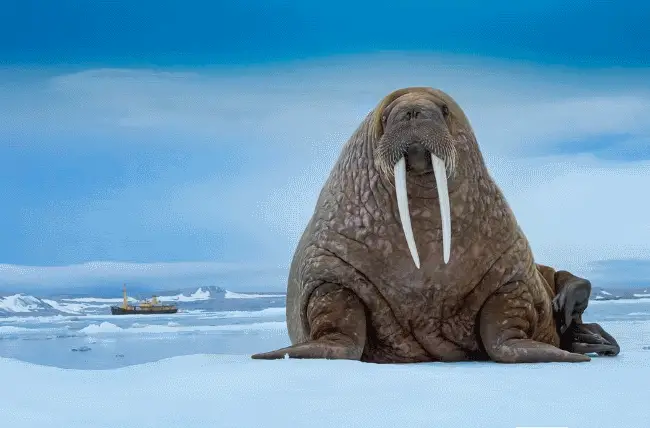Perhaps you might like to know what do walruses eat. Walruses are foraging and opportunistic predators that actively feed on bivalve mollusks. Apart from these, some other invertebrates on the menu of these animals include gastropods, crustaceans, amphipods, cephalopods and others. Fishes like polar cod may also become occasional diet of these marine mammals. When the food is not abundantly available, they may scavenge for carcasses of other large marine mammals like bearded seals. Each day, they consume around 3 to 6 percent of their own body weight.
What Do Walruses Eat in the Arctic?
They prefer foraging for benthic soft-bodied organisms, usually from the sea ice platform. They often do not dive to more than 262 feet in pursuit of food. Thus, unlike other pinnipeds, they live in shallow regions. Normally, they feed at a depth of around 33 to 164 feet.
All in all, they have a diverse diet and may include about 60 different genera of aquatic creatures. The prey items of walruses include sea cucumbers, snails, tube worms, shrimp, tunicates, octopuses, soft shell crabs, soft corals and mollusks like cockles, clams and mussels. In bivalve mollusks, the clams are probably the favorite diet of these mammals, consuming about 3,000 to 6,000 clams during one feeding. Each dive lasts for about 5 to 20 minutes and the walrus consumes about 60 clams in one dive.
Walruses often feed on shrimps, crabs, crustaceans, tube worms, corals, sea cucumbers, spotted seals, polychaetes, tunicates, and ringed seals.
They often forage for clams in muddy waters of the sea floor by spotting the prey through their acute vibrissae due to poor visibility. In order to clear the murky waters and locate invertebrates like clams, walruses are found to squirt jets of water at the sea floor. They are found to swallow the clam whole by sucking off its siphon. The walrus will dive to the sea bottom to eat clams and bivalve mollusks. Walruses usually suck the meat out of the marine organisms and they use their piston-like tongue to do so. They have pretty powerful lips which are locked into the prey sucking the entire meat all the way to the walrus’ stomach.
Scientists however do not know how much do and why do walruses eat seals. They have the ability to prey on 440-pound-bearded seal. According to the National Geographic, walruses do sometimes play with seabirds. At other times, they do however consume Uria lomvia.
Walruses are observed to eat fully on two occasions within 24 hours. During pregnancy, the female walruses tend to eat 30 to 40 percent more food than usual.

References
Fay, F. H. “Ecology and Biology of the Pacific Walrus, Odobenus rosmarus divergens Illiger.” United States Fish and Wildlife Service, North American Fauna 74 (1982): 1–279.
“Walrus - Diet and Eating Habits”. Seaworld Parks and Entertainment
“Walrus”. OCEANA - Protecting the World’s Oceans
Baker, H. 2013. “Odobenus rosmarus” (On-line), Animal Diversity Web. Accessed November 18, 2017 at http://animaldiversity.org/accounts/Odobenus_rosmarus/
Lowry, L. 2016. Odobenus rosmarus. The IUCN Red List of Threatened Species 2016: e.T15106A45228501. http://dx.doi.org/10.2305/IUCN.UK.2016-1.RLTS.T15106A45228501.en
Sheffield G.; Fay F. H.; Feder H.; Kelly B. P. (2001). “Laboratory digestion of prey and interpretation of walrus stomach contents”. Marine Mammal Science. 17 (2): 310–330. doi:10.1111/j.1748-7692.2001.tb01273.x.





